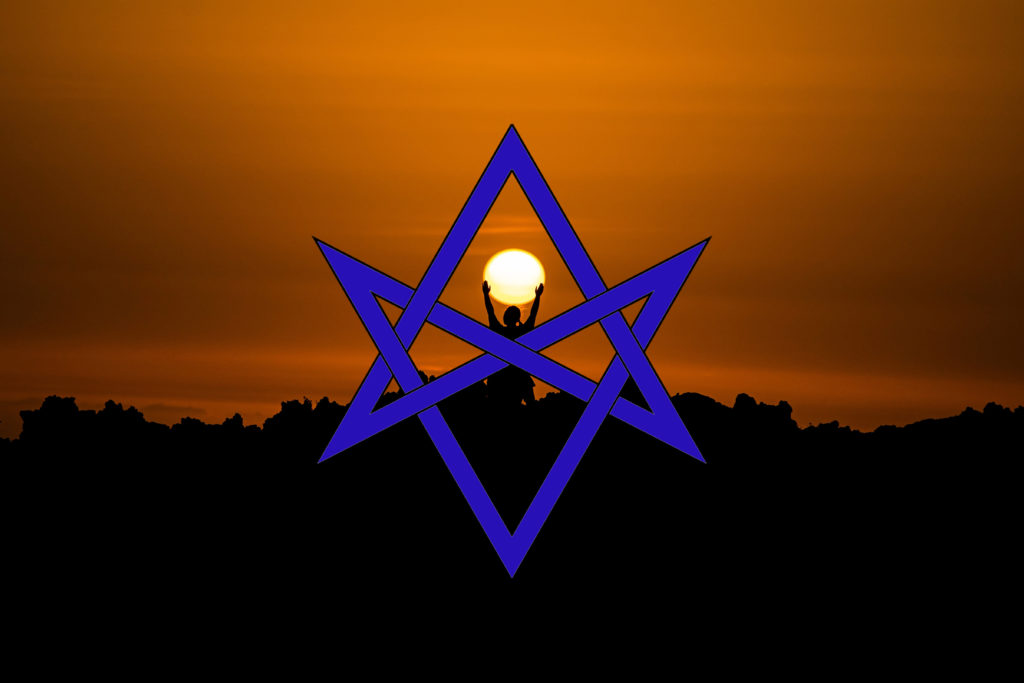
In the Platonic tradition, the Sun is a symbol of unity. It is the visible and sensible analog of the One Itself which gives unity in the purely intelligible realm. This One Itself transcends being and non-being. In fact it transcends all opposition whatsoever and is the sole cause of anything being whatever it is. For this reason it is also called the Good Itself.
The equivalent of the One in Thelema is Kether, which is also associated with Ra-Hoor-Khuit. Speaking in the 1st Aethyr of The Vision and the Voice, Ra-Hoor-Khuit declares:
I am light, and I am night, and I am that which is beyond them.
I am speech, and I am silence, and I am that which is beyond them.
I am life, and I am death, and I am that which is beyond them.
I am war, and I am peace, and I am that which is beyond them.
I am weakness, and I am strength, and I am that which is beyond them.
Yet by none of these can man reach up to me. Yet by each of them must man reach up to me.
The unity of opposites represented by Ra-Hoor-Khuit transcends both our capacity of reasoning as well as our capacities of sensation or intuition. Nevertheless, the Sun serves as a visual analog of this transcendent principle, much as it did for the Platonists. Thus four times a day, Thelemites turn toward the Sun and cry aloud:
Unity uttermost showed!
It is necessary to put ourselves into contact with transcendent unity, because as conditioned beings, we do not contain unity within ourselves.
Everything that we are or could even know—about ourselves or about the world—falls into five “heaps” or khandhas. We know by means of sensible impressions (rupa); the pleasure, displeasure, or boredom arising from them (vedana); perceptions (samjna); habituated tendencies (sankhara); and consciousness (vijnana). Each of these arises and passes beyond our control. Insofar as any of these abide for awhile, they change constantly. Therefore they are unreliable, and none can be said to be a self, to contain a self, to be under the control of a self, or to be in a self. None can provide lasting happiness. Even consciousness comes and goes throughout the day, when we fall asleep, or when we die.
For this reason, Crowley declared that the principle of unity of each person—as represented by their spiritual Sun, their Holy Guardian Angel—could not be found by means of introspection.
Apart from any theoretical speculation, my Sammasiti and analytical work has never led to so much as a hint of the existence of the Guardian Angel. He is not to be found by any exploration of oneself.
Magick without Tears, Chapter 43
And yet achieving unity is the preeminent goal of Thelemic ethics.
A Man whose conscious will is at odds with his True Will is wasting his strength. He cannot hope to influence his environment efficiently.
(Illustration: When Civil War rages in a nation, it is in no condition to undertake the invasion of other countries. A man with cancer employs his nourishment alike to his own use and to that of the enemy which is part of himself. He soon fails to resist the pressure of his environment. In practical life, a man who is doing what his conscience tells him to be wrong will do it very clumsily. At first!)
Magick in Theory and Practice, Introduction
Therefore turning toward the Sun four times a day is not a mere religious observance. It serves an important spiritual and ethical purpose.
By turning toward the Sun, we first admit that unity is not automatically present within us. As far as we have come in life, we still have work to do on ourselves. The process is continual. We can always improve.
Second, we recognize that the principle of unity—hence the principle of self-subsistence and enduring happiness—transcends who we ordinarily take ourselves to be. We recognize that when we identify with the skandhas, we’re like a person trying to build a house on quicksand.
Thelemites sometimes talk about the difference between the small-s self, which we identify with our egos, versus the big-s Self, which we identify with Jechidah or the Holy Guardian Angel. In fact there is only one self to speak of, since what we call “self” (with the small-s) is merely an illusion. When we turn toward the Sun, we allow its radiance to dispel this illusion all together, so that our entire being can enjoy contact with that which truly deserves to be called self.
He is the Open Eye of the exalted Sun, before whom all shadows flee away: also that Secret Eye which makes an image of its God, the Light, and gives it power to utter oracles, enlightening the mind.
Magick in Theory and Practice, Chapter 5
I adore the might of Thy breath,
AL III.37
Supreme and terrible God,
Who makest the gods and death
To tremble before Thee—I, I adore thee!
And then finally, having recognized the true source of unity beyond becoming, beyond opposition, we learn to surrender ourselves to it. Gradually we come to see ourselves as instruments or extensions of it. The more frequently we reestablish conscious contact with this spiritual unity or Jechidah, the easier and more habitual it is for us to find that lifeline and source of spiritual power in difficult times. We learn to tolerate misfortune with equanimity, knowing that even in the darkest hour, a radiant god stands at our backs.
And should we follow that lifeline back to its source, any one of us can pass through that “secret door / Into the house of Ra and Tum, of Khephra and of Ahathoor” and attain to direct awareness of that “center and secret of the Sun” which Crowley himself knew in his most exalted visions.
